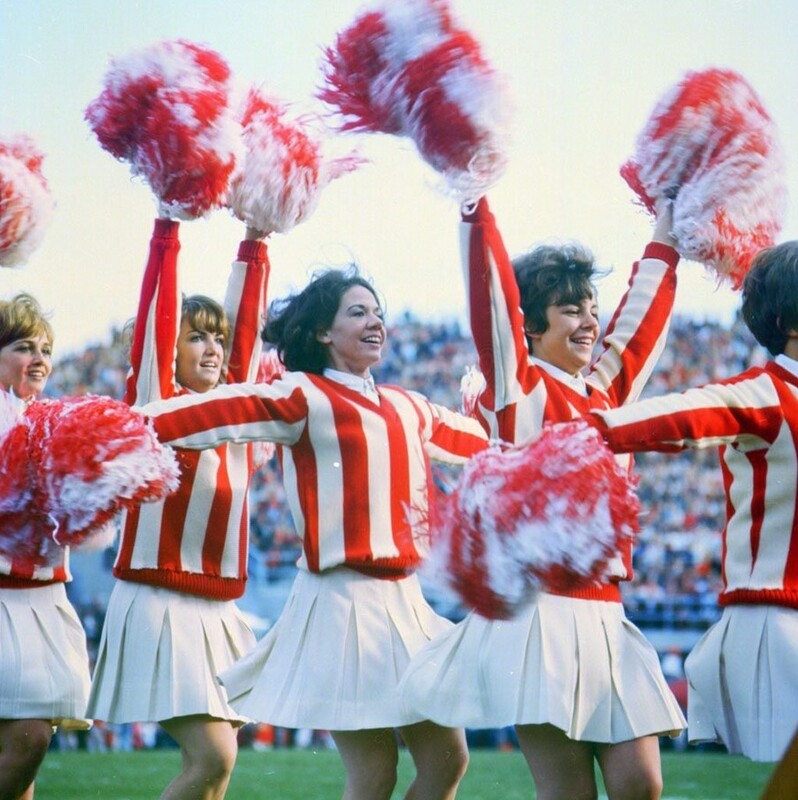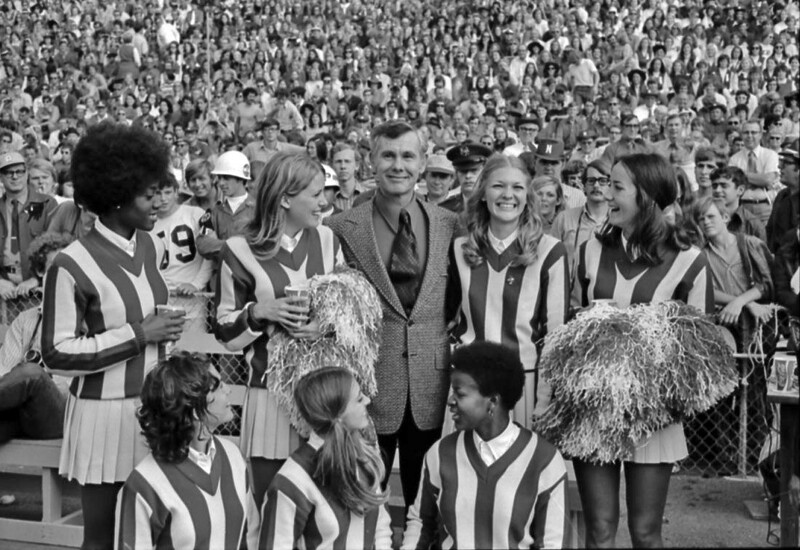The Decline of Husker Cheerleading
Ethan Graff, HIST 250: Historian’s Craft, Spring 2024
In December of 1996, Tracy Jenson, a University of Nebraska cheerleader was severely injured while practicing a routine on the Nebraska campus. As a result of that incident, in 2002 then athletic director Bill Byrne announced that the Nebraska cheer team would no longer be allowed to perform stunts or tumbling in their routines, meaning they were “grounded”. While he claimed that safety was the main concern, in reality money was the driving force behind the decision. The Athletic Department at Nebraska, beginning with Bill Byrne and continuing with Steve Pederson, prioritized saving costs and reducing insurance needs over the success of the Husker cheer squad on the basis of “safety”.
When Athletic Director Byrne first announced in March of 2002 that the Nebraska Cheer team would no longer be allowed to perform stunts during its routines, the reasoning he gave stemmed from two main concerns. He claimed the stunts themselves were too dangerous, and the cost to insure the program were too high. Both issues were directly related to the Tracy Jenson incident, with whom the University had just settled a lawsuit for $2 million. Byrne had been the Athletic Director at Nebraska since 1992, and had overseen the entire ordeal. Thoroughly against anything similar happening again, he made the controversial decsion to ground the team, “By eliminating risky routines, we can minimize the safety risks that go along with cheerleading.” Taking away those “risky routines”, stunting and tumbling, worked in significantly reducing thecosts related to insuring the program, but would prove to be deeply unpopular with almost everyone who heard the news.1
By 2002, cheerleading had existed in Nebraska for almost 100 years. Its history was as rich as almost any other program on campus, save football. When cheerleaders on the team heard the news, they were devastated. They did anything they could to convince Byrne to change his mind, to lighten up on them at all. He never did. Byrne left his post at Nebraska to become the athletic director for Texas A&M. By that point, the damage had been done. Byrne had kickstarted a decline in the cheer program, one that would take over a decade to recover from.
After the departure of Byrne, the University brought in Steve Pederson to captain the ship. A new face in the athletic director position reinvigorated the cheer team with a hope that Byrne's previous decision could be reversed. What they received was a wanting compromise.
On February 11, 2003, Pederson announced that the restrictions on the cheer team would be loosened, allowing the team to reintroduce some low-risk, basic stunts into their routines. However, tumbling and pyramids were still off the menu, much to the dismay of the team. They took what they could get, however, and learned to cheer with these slightly looser restrictions.2 Disappointment was becoming well known to the Husker cheer squad. In 2007, their coach departed, and Pederson changed his mind. Citing safety concerns, the cheer team would once again be completely grounded starting with the 2007-2008 season. No more stunting of any kind; they would be keeping their feet on the ground full time.3
Disappointment was becoming well known to the Husker cheer squad. In 2007, their coach departed, and Pederson changed his mind. Citing safety concerns, the cheer team would once again be completely grounded starting with the 2007-2008 season. No more stunting of any kind; they would be keeping their feet on the ground full time.3
In 2002 when Byrne made his decision, everyone in the state had an opinion on the matter, and they were not shy about voicing it either. Those most directly affected, namely the members of the team, were asked about their opinion on the matter. Josh Rangel, a junior at the time, claimed that taking away stunting took the, “Athleticisim out of cheerleading.” He did notfeel like an athlete anymore. Rangel came from Texas to Nebraska specifically to cheer for the team. Had he known the limitations that would be placed on the team, he would likely have gone someplace different.4
Other squad members shared a similar sentiment. Without stunting, cheering would not be the same. Crystal Zabka, a sophomore at the time, said that doing away with stunting meant breaking the traditions of cheering for the huskers. She had wanted to be a Husker cheerleader since she was little. This is not what she had envisioned.5
In 2003, when Pederson announced that the team could do limited stunting again, although basic ones, team members were naturally happy at the development. They thought this was the start of getting all of their limitations removed. They thought it was the start of things returning to normal. However, over the next four years, things did not return to how they were previously. They continued to perform their basic stunts, hoping they would be allowed to do more, until 2007 when Pederson came out with his adjusted policy for the team. Squad members got a sense of déjà vu. Just as before, they were blindsided with the news that they would be restricted to the ground. When they went to the athletic director for answers, none were found. The athletic department told cheerleaders that director Pederson was not even allowed to meet with cheerleaders. Despite that, Christy Childers, a sophomore cheerleader, ran into Pederson at a basketball game and attempted to voice her disagreement about the grounding. Pederson responded with, “I don't worry about the cheerleaders. That's Carrie's (Vitullo) job.” 6
Vitullo was the team’s new coach, who had done little to remedy the situation. The athletic administration continually showed that they cared more about saving money than they did about what would truly be best for the team. The same year that they grounded the team for the second time, they cut their textbook scholarship and food allowances. The athleticdepartment was consistently unclear, specifically with why they were making the decisions that they were. Whenever asked why the squad was being grounded, their only comments were “safety concerns”. Unlike the decision by Byrne, this one came with no prior incident. No one had been injured, no one had fallen, but they were grounded all the same.7
That much turmoil is going to have an effect. Prior to the 2002 grounding, the Nebraska cheer team had a winning culture built up over decades. From the 80s to the late 90s the team went to the College Cheerleading Championships several times. In 1989 they placed seventh. The year after that they placed fourth. In 1996 they performed at the opening ceremonies of the Summer Olympics. Following that, they went to nationals again, placing fifth in 1996, and second in 1997. Their success had cemented the Huskers as one of the greatest cheer teams in the country. Then the 2000s came and everything changed. The team could not compete if they could not stunt or tumble. Byrne and Pederson had taken away both.8
The team’s decline in competitiveness, coupled with the restrictions placed on them by the athletic department led to a sharp decline in the numbers on the team. In 1998, the team was comprised of 36 members. By 2008, that number had dropped to 16. High School cheerleaders no longer wanted to come to Nebraska. Byrne’s decision had taken significant incentive for out-of-state cheerleaders to come to the school. However, not only would potential new members be disinclined to come to UNL, the best members on the team might look to go somewhere where their talents would be better used. Kris Baack, an advisor to the team in 2002, said herself, “People who really want to be somewhere where they can tumble and stunt will leave”. The talent level on the team was going to take a hit. Members of the team knew it. Students knew it. Byrne knew it.9
The size of the team had gone down, but the makeup had declined as well. By doing away with stunting, Byrne and Pederson had done away with any need for bases on the team, the men responsible for tossing and holding the women in the air during their routines. For the 2003-2004 Season, only four men returned to their positions. By 2008, none remained. Just as the women would go to a school where they could show off their talent and stunt, so too would the men go someplace where they could be of use, more so than standing on the sidelines yelling chants.10
Byrne and Pederson cited multiple times that the risks associated with cheerleading were the cause of the restrictions placed on the team. Because of those risks, they claimed, the insurance was too high to justify. However, the incident that took place at Nebraska was an outlier, and one that was statistically unlikely to happen again. Nationally, serious cheerleading incidents were a rarity, and when compared to other collegiate sports, practically non-existent.11
Jim Lord was the executive director of the American Association of Cheerleading Coaches and Advisors in 2002. His organization set standards and guidelines for safety, and also monitored cheerleading-related incidents around the United States. Between 1990 and 2002, there were only 25 serious injuries to cheerleaders across all of high school and college athletics. Of those 25 injuries, 17 fully recovered. According to Lord’s organization, over that same 12-year span, over 280 similarly serious injuries were recorded from high school and college football.Despite that stark difference in numbers, Byrne and Pederson still made the decision to ground the cheer team based on the one incident.
Bill Byrne and Steve Pederson, during their times as athletic director at Nebraska continually prioritized money over the success of the cheer team. This was made clear after Byrne initially grounded the squad in 2002 because the insurance was “too high”, and again in2007 when Pederson grounded them again and reduced their scholarships as well. If safety truly were their biggest concern, they had options. Instead of hiring more coaches, bringing in more people to watch over practices, or moving the team to a safer practice environment, they elected to ground the squad, thereby reducing the quality of the team, but saving them money.
Notes
1. Associated Press. “Cheerleaders Told to Eliminate Moves, Stick to Cheers.” ESPN, March 13, 2002. https://www.espn.com/ncaa/news/2002/0313/1350749.html; Schreier, Laura. “Byrne Bans Cheerleaders’ Stunts.” The Daily Nebraskan, March 12, 2002. https://www.dailynebraskan.com/byrne-bans-cheerleaders-stunts/article_0a4fea3b-fea4-5 e32-b0d6-29dbd720ec21.html
2. White, Debra Kleve, and Tom Osborne. The spirit of Nebraska: A history of Husker game day traditions, the Tunnel Walk, mascots, cheer, & more. (Lincoln, NE: Cheerful Books, 2019) 224, [White, The Spirit of Nebraska]
3. “Uncertified Sponsor Keeps Cheerleaders Grounded.” The Daily Nebraskan, March 1, 2007. https://www.dailynebraskan.com/uncertified-sponsor-keeps-cheerleaders-grounded/articl e_da991d16-2ccc-517a-b50a-3c4a17daea28.html.
4. Associated Press, 2002; Schreier, Laura. “Byrne Bans Cheerleaders’ Stunts.” The Daily Nebraskan, March 12, 2002. https://www.dailynebraskan.com/byrne-bans-cheerleaders-stunts/article_0a4fea3b-fea4-5 e32-b0d6-29dbd720ec21.html [Scheier, Laura, Byrne Bans Cheerleaders’ Stunts]
5. Schreier, Laura, 2002
6. White, The Spirit of Nebraska, 46; Daily Nebraskan, 2007
7. Melissa Lee / Lincoln Journal Star. “Nu Cheerleaders Cry Foul over Policy Changes.” JournalStar.com, March 6, 2007. https://journalstar.com/news/local/nu-cheerleaders-cry-foul-over-policy-changes/article_5 415dfdd-98f8-56d9-9167-9ac6bfc1648f.html.
8. White, The Spirit of Nebraska, 45
9. White, Debra Kleve. “Rosters: 1990-2005.” Spirit of Nebraska, 2019. https://www.spiritofnebraska.com/rosters-1990-2005; White, Debra Kleve. “Rosters: 2005-2019.” Spirit of Nebraska, 2019. https://www.spiritofnebraska.com/rosters-2006-2019; Scheier, Laura, Byrne Bans Cheerleaders’ Stunts, 2002
10. White, The Spirit of Nebraska, 2019; Vannoy, Patti. “Grounded Cheerleaders Frustrated.” The Daily Nebraskan, November 4, 2002. https://www.dailynebraskan.com/grounded-cheerleaders-frustrated/article_03a24bcf-af62-5977-bd0d-12f61528250c.html.
11. The Associated Press. “Nebraska Cheerleaders Keeping Feet on Ground.” The Tuscaloosa News, August 23, 2002. https://www.tuscaloosanews.com/story/news/2002/08/23/nebraska-cheerleaders-keepingfeet-on-ground/27826103007/. [Associated Press, Nebraska Cheerleaders, 2002]
12. Associated Press, Nebraska Cheerleaders, 2002
Picture Citations
1. Archives & Special Collections, University of Nebraska-Lincoln Libraries


